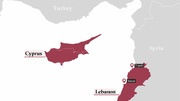-
 2025-12-16 22:07
2025-12-16 22:07
University of Arkansas fires Iranian scholar for criticizing Israel
Silencing Shirin Saeidi, Belying Claims
When U.S. actions nullify its rhetoric on women's rights in Iran and free speech
TEHRAN – The removal of Dr. Shirin Saeidi from her post as director of the Middle East Studies Program at the University of Arkansas should not be read as a narrow personnel matter or an incidental university policy dispute.
-

By Shahrokh Saei
Beyond bombs: Israel’s expansionist narrative in Lebanon
TEHRAN – Israel is waging a hybrid war against Hezbollah in Lebanon, weaving continued military strikes with a propaganda campaign and ongoing occupation. This multi-front assault is not merely tactical; it is a strategic effort to lay the diplomatic and narrative groundwork for a far broader military escalation.
-

By Sondoss Al Asaad
Turkish discontent with Lebanon over the Cyprus maritime agreement
BEIRUT—Turkey’s dissatisfaction with Lebanon has crystallized sharply following Beirut’s decision to sign a maritime border demarcation and exclusive economic zone (EEZ) agreement with Cyprus with coordination with Ankara or Damascus.
-

By Wesam Bahrani
Behind the Israeli assassination of Raed Saad
TEHRAN – The Israeli regime assassinated the second-in-command of the al-Qassam Brigades on December 13. What is the regime's objective?
-

Araghchi highlights strategic partnership with Russia in Moscow meeting
TEHRAN – Iran’s Foreign Minister Abbas Araghchi on Tuesday underscored the strategic depth of Tehran–Moscow relations during a meeting with a group of Russian intellectuals and policy experts in Moscow, as part of consultations on bilateral ties and key international developments.
-

Europe’s restoration of Iran sanctions ‘disgrace for diplomacy’: Russian FM
TEHRAN – Russian Foreign Minister Sergey Lavrov says the reinstatement of illegal sanctions against Iran by Europe amounts to a “disgrace for diplomacy.”
Politics
-

Tehran calls for 'transparent, all-inclusive process' to pick UN chief
TEHRAN – Iran’s Ambassador and Permanent Representative to the United Nations says Tehran demands a “transparent and all-inclusive process” to select the world body’s Secretary General, and announces its preparedness to take part in “meaningful talks” throughout this process.
-

High-level Iran-Russia talks set North–South Corridor on path to operation
TEHRAN – Iran’s Secretary of the Supreme National Security Council, Ali Larijani, and Russia’s Deputy Prime Minister for Transport, Vitaly Savelyev, emphasized the need to fast-track the strategic North–South Transport Corridor during high-level talks in Tehran on Tuesday.
-

UK Parliamentary Committee repeats allegations about Iran in annual security report
TEHRAN – A new annual report by the UK Parliament’s Intelligence and Security Committee has once again included Iran in its assessment of security threats and foreign influence, citing the country in connection with alleged cyber and state-affiliated activities.
Sports
-

Persepolis to part ways with Serge Aurier
TEHRAN – Persepolis football club are set to part ways with Ivorian defender Serge Aurier, bringing an early end to his short and disappointing spell in Iranian football.
-

Sepahan beat Foolad: 2025/26 PGPL
TEHRAN – Sepahan football team edged past Foolad 1-0 in the 2025/26 Iran Persian Gulf Professional League (PGPL) on Monday.
-

Fatemeh Sharif takes charge of Pakistan women’s futsal team
TEHRAN - The Pakistan Football Federation (PFF) on Sunday confirmed the appointment of Fatemeh Sharif Noghabi as the head coach of its national women’s futsal team.
Culture
-

Baghcheban children's theater festival kicks off in Marand
TEHRAN- The 3rd edition of the Baghcheban National Children and Youth Theater Festival commenced in Marand, East Azarbaijan province, on Monday with the participation of theatrical groups from across the country.
-

Book celebrating life of Martyr General Qassem Soleimani republished
TEHRAN- The 7th edition of the book "Qassem," authored by Iranian resistance literature researcher Morteza Sarhangi, has recently been published.
-

English translation of “Nigaristan” published by Edinburgh University Press
TEHRAN – The English translation of the book “The Picture Gallery (Nigaristan): A Persian Moral Miscellany” has been released by the Edinburgh University Press.
Economy
-

Steel chain exports rise 41% in 8 months on year
TEHRAN- The volume of Iran’s steel chain export has increase 41 percent in the first eight months of the current Iranian calendar year (March 21-November 21), as compared to the same period of time in the previous year, Iranian Steel Producers Association (ISPA) reported.
-

Iran-Uzbekistan agricultural trade to be facilitated
TEHRAN- During a meeting between the heads of the Plant Protection Organizations of Iran and Uzbekistan, emphasis was placed on developing bilateral cooperation in the fields of plant quarantine, pest control, and facilitating the safe trade of agricultural products.
-

Iran’s tea export increases 48%
TEHRAN- The head of the Iranian Tea Organization said this (Iranian calendar) year (began on March 21), the country's tea exports have increased by 48 percent compared to the same period last year, and close to 9.8 million kilograms of tea were exported to foreign markets.
Society
-

Bolivia health ministry seeks to boost ties with IRCS
TEHRAN – The Bolivian Minister of Health and Sports, Marcela Tatiana Flores Zambrana, has expressed her country’s willingness to promote cooperation with the Iranian Red Crescent Society (IRCS) in the health sector, particularly the provision of hemodialysis and medical equipment.
-

Intl. conference on mobile learning to focus on AI
TEHRAN – The first international and the fourth national conference on mobile learning, titled ‘Mobile learning in the age of artificial intelligence (AI): transformation of educational and vocational training system in industry’, is scheduled to be held on February 16 and 17 in Tehran’s Allameh Tabatabai University.
-

Khwarizmi Youth Award winners honored
TEHRAN – The 26th Khwarizmi Youth Award (KYA) honored 54 winners on Tuesday in a special ceremony at Shahid Beheshti University of Tehran, with science minister Hossein Simaei-Sarraf in attendance.
Tourism
-

Iran’s Khoy and Turkey’s Konya sign sister-city agreement
TEHRAN - The Iranian city of Khoy and Turkey’s Konya have signed a sister-city agreement, committing to expand cooperation in spiritual tourism, cultural exchanges, urban management and sustainable infrastructure development, officials said.
-

Zoroastrian lawmaker highlights restoration of historic fire temples
TEHRAN — An Iranian lawmaker representing the Zoroastrian community has called for continued restoration and protection of historic fire temples in the central province of Isfahan.
-

Iranology goes beyond academia, Armenian researcher says
TEHRAN—Iranology is a quiet diplomacy between Iran and Armenia. Mariam Zazyan, an Armenian Iranologist, believes that being an Iranologist has a responsibility beyond academic study and can play an effective role in strengthening the cultural and friendly relations between the nations.
International
-

Israel’s media war fails to divide Iran and Lebanon
TEHRAN – Israeli media and their affiliates recently tried to stir the pot, spotlighting a brief back-and-forth between Iranian Foreign Minister Abbas Araghchi and his Lebanese counterpart Youssef Raggi, in an effort to paint the two countries as being at odds.
-

Turkish discontent with Lebanon over the Cyprus maritime agreement
BEIRUT—Turkey’s dissatisfaction with Lebanon has crystallized sharply following Beirut’s decision to sign a maritime border demarcation and exclusive economic zone (EEZ) agreement with Cyprus with coordination with Ankara or Damascus.
-

Behind the Israeli assassination of Raed Saad
TEHRAN – The Israeli regime assassinated the second-in-command of the al-Qassam Brigades on December 13. What is the regime's objective?
Video Comment
-

Ayatollah Khamenei’s vision of freedom and humanity discussed in intl. conference
-

Iran hosts SCO joint anti-terror drills
-

Holy Mary Metro Station marks interfaith unity in Tehran
-

Academics analyze social dimensions of Resistance in Tehran conference
-

Culture minister highlights year of progress in arts, global image enhancement
Most Viewed
-
Australia’s tragedy won’t wash Netanyahu’s bloody hands
-
Afghanistan’s neighbors gather in Tehran to coordinate support for the war-torn country
-
Iran’s free zones attract $461m in foreign investment in 8 months
-
Iranian students shine at World Mathematics Team Championship 2025
-
What Iran’s foreign ministry spokesman said at his weekly briefing
-
Israel’s misstep and the resilience of Iran’s strategic autonomy
-
‘A very positive path’: Iran and Belarus strengthen alliance against sanctions
-
Iran ready to foster tech ties, share expertise with Ethiopia
-
Full Israeli-US support for opposition and terrorist groups
-
Hezbollah’s move in launching Women’s Action Unit marks a milestone
-
Israel’s media war fails to divide Iran and Lebanon
-
“Where’s Daddy?”: How Israel and US tech turn Gaza’s homes into graves
-
Maritime-oriented economy a unique opportunity for Iran: PMO head
-
Professor faults Kabul for failure of Pakistan-Afghanistan peace talks
-
Tehran hosting intl. transport, logistics exhibition







